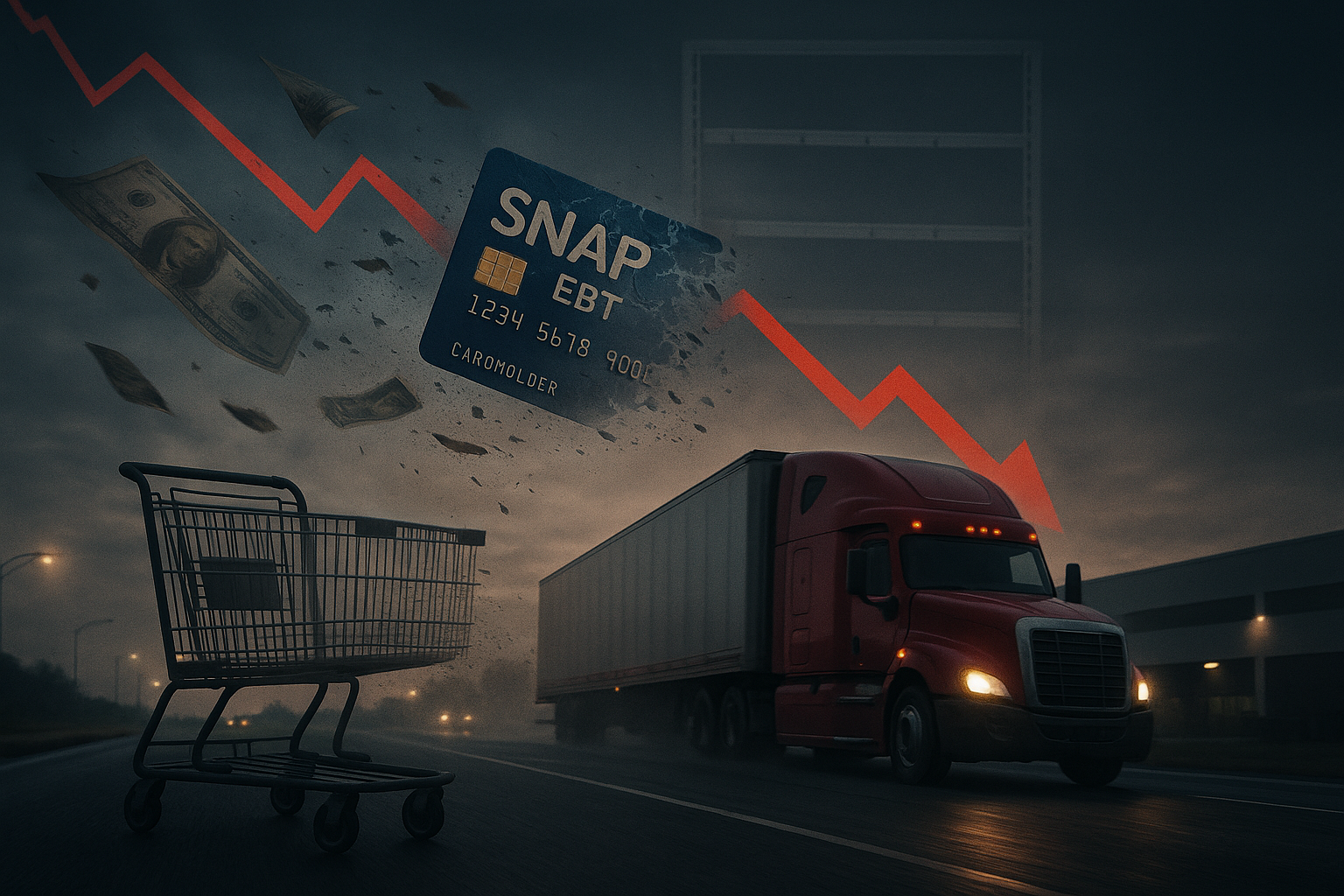The loss of Supplemental Nutrition Assistance Program (SNAP) benefits isn’t just a hardship for families—it’s a clear warning light for the US freight market. When SNAP payments dry up, a chain reaction starts: fewer groceries bought, fewer retail goods moving, fewer trucks on the road. For anyone tied into logistics, transport, or supply-chain forecasting, this isn’t a side effect—it’s a signal.
The basic link: SNAP and freight
SNAP benefits are designed to help low-income households purchase food and essential items. Research shows that when SNAP payments go out, recipients spend that money quickly. That rapid spending translates into goods moving fast through grocery stores, wholesalers, food suppliers—and by extension, the freight industry. When SNAP payments stop or are delayed, that spending pulls back. Less buying equals less moving. In turn, freight volumes drop.
Why this matters for freight markets
Let’s break out the mechanics:
- A large portion of SNAP purchases happen in grocery stores and food retail. That triggers downstream demand for packaging, transport, warehousing and shipping.
- The freight market is tightly tied to consumer goods and retail cycles. When consumer spending dips, freight volumes typically follow.
- A recent estimate: if SNAP benefits go unpaid, the effect is not just on households—it hits the transport chain. For example, one analysis warned of freight volumes already down ~18.5% year-over-year, partly because the safety nets like SNAP are under strain.
So, the loss of SNAP benefits doesn’t operate in isolation; it moves upstream and downstream across the supply chain.
The numbers tell the story
According to the USDA Economic Research Service, an additional $1 billion in SNAP benefits during a weak economy increased GDP by $1.54 billion—meaning the multiplier effect is strong. The trade and transportation industries alone gained about $406 million in output from that boost.
If that’s the upward effect, then conversely: removing or delaying SNAP benefits removes that economic stimulus. Fewer dollars circulating means fewer goods purchased, and fewer goods moved—and freight operators will feel it.
The current danger zone
Right now, the backdrop is worrying: government funding lapses, potential pauses in SNAP payments. One report highlighted that if Congress didn’t act, more than 42 million Americans could see SNAP benefits stop, and states warned of “billions of dollars” leaving local economies. For the freight market, this is a double-whammy:
- Demand shock from households cutting back 2. Logistic ripple effects as retailers and suppliers adjust
In sum: the loss of SNAP benefits could slow the freight market in ways that go beyond headline numbers.
What freight operators and firms should watch
- Retail sales data: A drop in grocery or essential goods sales, especially in regions with high SNAP participation.
- Truckload and less-than-truckload volumes: If data shows flattening or decline in staple goods shipments, it may trace back to lowered consumer spending.
- Regional variations: States with larger proportions of SNAP recipients may be early warning zones.
- Inventory build-or-not decisions: Retailers may hold back goods if consumer demand softens, which reduces freight.
- Policy updates: Any federal decision to pause, reduce, or delay SNAP payments signals downstream stress for the freight market.
Why it’s not just “food trucks” that matter
It’s easy to assume SNAP affects only grocery trucks—but the web is wider:
- Grocery chains order goods and move them from regional distribution centres.
- Packaging and durable goods tied to food consumption move too.
- Retailers might cancel or reduce orders if they expect weaker consumer purchases, which again reduces transport demand.
Hence, the loss of SNAP benefits may slow freight in segments beyond just food transport.
Potential ripple effects on the freight ecosystem
- Idle capacity: If freight volumes drop, carriers may face unused trucks, fewer loads, and thus higher per-unit costs.
- Rate pressure: Lower utilization means carriers might push rates up, or accept lower margins—both bad for efficiency.
- Operational scheduling shifts: Warehouses may reorder, carriers may change lanes, leading to less optimal logistics networks.
- Investment hesitation: If volumes stay weak, investment in new fleet, technology or expansion could stall.
So the loss of SNAP benefits isn’t only a consumer welfare issue; it’s a structural freight network concern.
What can firms do to adapt
- Scenario-plan: Model what happens if SNAP payments are delayed for one or more months. What happens to your volumes?
- Stress-test routes: Identify which lanes or goods flows are sensitive to consumer demand—those tied to food, daily essentials, grocery supply.
- Flexible capacity: Build flexibility so you can ramp up or down load commitments as volumes shift.
- Diversify: consumer staples vs discretionary: Firms that lean heavily on goods purchased by SNAP households may want to diversify into other markets less sensitive to those payments.
- Monitor policy developments: Because this is a policy-linked risk scenario, stay up to date with funding debates, USDA announcements, state-level alerts.
Conclusion
The link is clear: SNAP benefits drive consumer spending, which drives goods movement, which drives freight volumes. Losing those benefits or having them delayed isn’t just a social support issue—it’s a freight market signal. For professionals in logistics and transport, this is a moment to pay attention. The loss of SNAP benefits could slow the freight market significantly—and the smart move is to prepare accordingly.
FAQs
Q1: How exactly does the loss of SNAP benefits impact freight volumes?
It reduces consumer spending among low-income households. Because those households spend quickly, especially on essentials, fewer purchases mean fewer goods entering the supply chain. That reduction in movement translates into lower freight volumes for grocery goods and other consumer-driven shipments.
Q2: Are there estimates of the economic impact of SNAP benefit removal?
Yes. The USDA’s Economic Research Service found that every additional $1 billion in SNAP benefits could raise GDP by $1.54 billion, with transport and trade industries gaining roughly $406 million. Thus, removing or delaying benefits removes that economic stimulus.
Q3: Which segments of the freight market are most vulnerable?
Segments tied to consumer essentials—grocery goods, food processing, retail distribution—are most vulnerable. Also, regional freight markets in states with high SNAP participation may feel the effects earlier and harder.
Q4: How fast can the freight market feel the effects?
Potentially very fast. Since SNAP recipients tend to spend their benefits quickly, a pause in payments can translate into decreased retail demand within weeks, which then affects distribution and freight logistics almost immediately.
Q5: What risk mitigation strategies do freight companies have?
They can scenario-plan for demand drops, diversify into less-sensitive freight segments, increase flexibility in capacity commitments, stay alert to policy developments, and monitor retail sales and inventory data closely.
Q6: Does this mean the freight market is doomed if SNAP benefits stop?
Not necessarily doomed—but definitely under pressure. If the loss of SNAP benefits is short-lived or mitigated, the effect may be limited. However, if delays extend or benefits are cut significantly, freight volumes could contract enough to trigger cost pressures and structural shifts in logistics networks.


